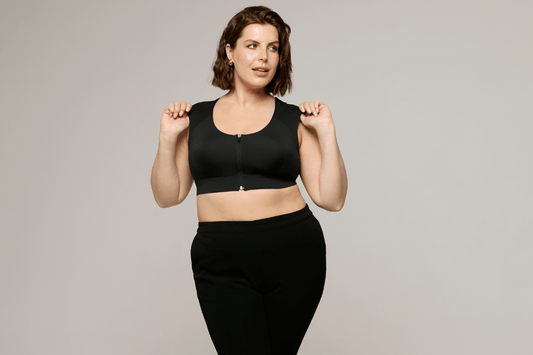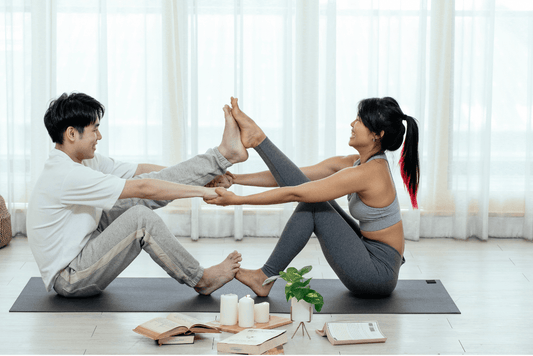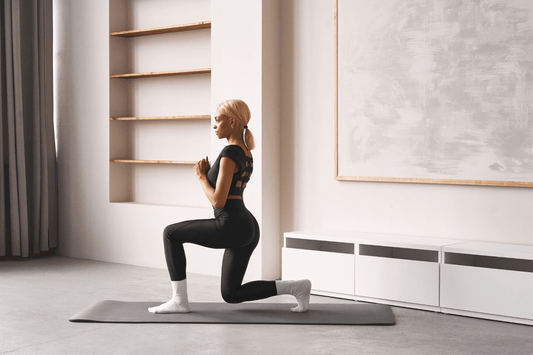There’s no doubt about it: working out does a mind and body good. But all good things have their limitations. Building strength and endurance should come with some discomfort (“no pain, no gain,” right?), but not the wrong kind of discomfort. There’s a delicate balance between pushing yourself and going too far, and when you start to lean into the latter, injuries are inevitable.
When we consider poor posture, we’re often thinking about “tech neck” or slouching at our desks. However, perhaps ironically, the biggest risks of bad posture can come when you’re trying to improve it — through exercise. Not all of us have access to a coach or personal trainer, so how can you ensure that you’re keeping good posture while working out? Should you wear a posture corrector?
Let’s dig into the benefits and drawbacks of using a posture corrector for exercise and how to best maintain good posture — at the gym, at your desk, and everywhere in between.
Benefits of using a posture corrector while working out
Good posture can be hard to maintain throughout a workout, especially as you start to exhaust your muscles. The right type of posture bra can help improve your form and train your body to find proper alignment while exercising.
Wearing a comfortable and effective posture corrector while working out can help:
- Promote good posture and proper alignment of the spine
- Improve form and performance
- Reduce unnecessary strain
- Encourage proper muscle engagement
- Train your body to know and feel what good posture is
- Reduce pain and risk of injury
That said, not all posture-correcting devices are fit for working out. In fact, some can be downright harmful — keep reading to learn why and how to choose the best posture corrector for exercise.

Drawbacks of wearing a posture corrector during exercise
Some people believe that working out with a back brace on is an absolute no-no. The idea here is that it will do the opposite of what you intend it to do — that it will limit your movement and only weaken the muscles used to promote good posture.
This can be true if you’re wearing a restrictive back brace that limits your range of motion. The goal is to be able to move freely throughout an entire movement, especially if you’re doing cardio or weightlifting. Restricted movement from a back brace can:
- Limit your performance
- Impact your focus
- Reduce muscle activation
- Cause you to favor certain muscles
- Put you at risk for an injury
An ill-fitting posture corrector made with low-quality fabric can also cause chafing or skin irritation.
As far as the belief that a posture corrector will lead to over-reliance and lazier muscles — there’s actually no research to back this up (1). A posture corrector that fits well and targets your weak areas should actually help activate the muscles that have become “lazy” due to poor posture. It will also help improve proprioception (the awareness of the position of your body) by giving the brain cues on how to maintain good posture.
How to choose a posture corrector for exercise
You can wear a posture corrector while running, lifting, or performing any other type of movement as long as it follows a few important guidelines. When choosing a posture corrector for exercise, make sure that it:
Fits properly. Your body is a unique vessel — it’s like no one else’s. Not every posture corrector will fit you well, so your best option is one that is customizable. A posture corrector with adjustable straps or settings will allow you to shape the device to your body and target your weakest areas.
Allows you to move freely. If your posture corrector fits properly it should also not restrict your movement. When exercising, you want to be able to have full range of motion to properly execute any lift, step, or pose.Is comfortable, breathable, and durable. To avoid discomfort, especially chafing or skin irritation, choose a posture corrector that is made with breathable, high-quality materials that hold up throughout your toughest, sweatiest workout sessions. Addresses the root cause of your slouching, pain, and/or discomfort. A posture corrector is not meant to wrench you into an upright position. Insead, it should work to target the muscle imbalances that are leading you to slouch or causing you pain. A posture bra that gently pulls the shoulders back and opens up the chest can help you find better posture through most exercises.
Wearing a posture corrector for the first time may feel a little strange, but it shouldn’t feel uncomfortable. Learn more about how to use a posture corrector for maximum effectiveness. If you’re unsure about using one, consult a doctor to discuss what type of posture corrector may be best for you.
What exercises can help improve posture?
A posture corrector is a valuable tool to help activate your muscles and improve your form and technique. But when it comes to improving your posture, you have to do a little work yourself, too! Incorporating posture-promoting stretches and strengthening exercises to your regular workout routine will help correct muscular imbalances due to poor posture and improve mobility and flexibility.
Tack on just 5-10 more minutes to your workout to target the main posture muscles, including those in the upper back (the traps, lats, and rhomboids). Some recommended exercises to help improve posture include:
- Planks
- Upright rows
- Pull-ups
- Pull-downs
- Wall slides
- Reverse flys
- Seated rows
- Push-ups
See more exercises to improve your posture here and here. Add resistance to these movements using Etalon Posture Bands. These are portable and versatile tools for stretching, strength training, and building up those postural muscles.
Maximizing the effectiveness of posture correctors during workouts
Wearing a posture corrector while exercising can help you train with proper form, correct muscular imbalances, and avoid injury when working through different ranges of motion. It also allows you to “get into the zone” — you shouldn’t have to overthink your posture with every movement.
To get the most out of these benefits, make sure that your posture corrector fits properly (you don’t want it too tight or loose), allows for full range of motion, and doesn’t irritate your skin.
Using a posture corrector and incorporating posture-improving exercises and stretches is the most effective way to a better posture. Maintaining good posture while working out will inevitably carry over to the times you’re more likely to slouch — like when you’re at your desk working, at the table eating, or going out for a leisurely walk.
FAQs
- Can I wear a back brace during exercise?
Absolutely! Wearing a back brace or posture corrector during exercise can help you maintain proper form, activate your postural muscles, and help prevent injury. Just make sure it’s a posture corrector that is comfortable, breathable, and does not restrict your movement.
- Is it bad to work out with a back brace on?
It depends. It’s not bad to work out with a back brace on as long as it fits you properly and allows you to move freely. A restrictive brace that is too tight could cause muscle imbalances and may lead to injury.
- Should I run with a posture corrector?
Running and walking with good posture allows for better oxygen intake, improved muscle endurance, balanced weight distribution, and reduced risk of injury. You can wear a posture corrector while running to promote better posture. Just make sure it allows you full range of movement and does not cause chafing. To protect your skin, make sure you choose one that is made with breathable and high-quality materials.
- Does wearing a back brace really prevent injuries when doing heavy lifting?
A back brace will not always save you from injuries — especially if you’re lifting in an unsafe environment with too heavy of weight. However, a properly fitting posture corrector that doesn’t restrict your movement can help encourage better form when heavy lifting.
- Will wearing a back brace affect the benefits of push-ups?
A back brace won’t directly affect the benefits of push-ups, but push-ups are a great exercise to activate the muscles in your arms, shoulders, core, and legs — all crucial in maintaining good posture.
SOURCES:
- GoodRx Health: Do Posture Correctors Work? https://www.goodrx.com/well-being/movement-exercise/do-posture-correctors-work
Trending
Try Etalon posture improvement products










